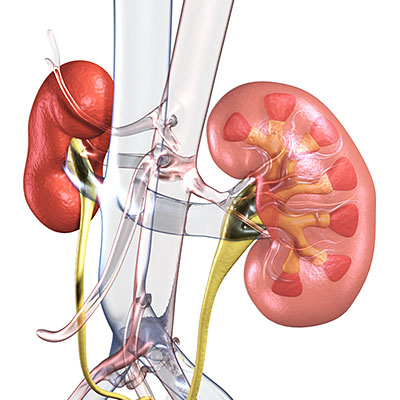Overview
What is Kidney Cancer
Kidney cancer (also called renal cell carcinoma, kidney adenocarcinoma or hypernephroma, or renal cancer) accounts for about 3 percent of new cancers in the United States.
There are several forms of kidney cancer: clear cell (75 to 80 percent of tumors) and papillary tumors (10 to 15 percent of tumors). There also are subtypes, such as ococytomas and chromophobe, which are less aggressive forms of kidney cancer. Another type, Wilms’ tumor is found almost exclusively in children.
Symptoms of kidney cancer can include blood in the urine, abdominal pain and an abdominal mass. Individuals also may experience, anemia, bone pain, unexplained weight loss, low-grade fever, general weakness or loss of energy and loss of appetite. However, many patients with kidney cancer are asymptomatic and the tumor is found by chance during a medical exam.
At present, there are no helpful screening tests for kidney cancer. Diagnosis is made using a medical history, physical exam, and blood and imaging tests.
Diagnosis

How is kidney cancer staged?
The information gathered through examinations and diagnostics helps cancer specialists determine the stage of cancer. The stage indicates how widespread the cancer is, the best treatment options and the patient’s prognosis.
There are several staging systems. The most commonly used is the TNM system in which T = tumor, N = lymph node involvement, and M = metastases, or the spread of cancer cells to locations outside of the kidney. Each letter is followed by a number to indicate the extent of tumor growth, whether it has spread to the lymph nodes, and whether it has spread to other sites.
How is kidney cancer graded?
Pathologists “grade” the cancer according to the nature of the cancer cells within the tissue samples they have received from biopsies. Grading classifies cancer cells by how they look under the microscope and how quickly the tumor is likely to grow and spread. There are two main grades: low grade and high grade. Low grade cells may vary in size but most look relatively normal. Only a few of these cells multiply within a tissue sample. High grade cells make for the most aggressive form of kidney cancer. They are distorted, vary greatly in size and appear to be rapidly dividing.
Surgical Treatments

How is kidney cancer treated?
Surgery remains the customary treatment option for most kidney cancer patients. Other procedures may be offered as secondary treatments or primary treatments when surgery is not permitted because of other conditions the patient may have. At Cleveland Clinic, individualized surgical treatment plans offer patients open and laparoscopic techniques. When discussing surgical options, you should also consider the experience of the surgeon. It is important to note that not all patients are candidates for the laparoscopic approach; however, at Cleveland Clinic we have the world’s largest experience in both treatment methods.
Standard open technique – An incision is made in the patient’s side and the whole kidney is removed (radical nephrectomy), or just the part of the kidney harboring the tumor (partial nephrectomy) is removed, with minimal disturbance to adjacent organs.
Laparoscopic (minimally invasive) technique – Incisions no more than a few centimeters are made and narrow tubes are inserted into the abdomen near the kidneys. Video and surgical instruments are inserted through tubes to allow the surgeon to conduct the procedure within the body.
Open partial nephrectomy
Cleveland Clinic has performed more than 3,000 open partial nephrectomies during the past 30 years.
In the past, kidney tumors were removed only by removing the entire kidney (radical nephrectomy). But doctors realized that for many patients complete removal is unnecessary. The risk of cancer recurrence for appropriately selected patients was no higher for partial nephrectomies.
At Cleveland Clinic, we have pioneered the partial nephrectomy approach that spares the kidney by removing only the diseased portion, saving kidney tissue that may be needed later in life. This procedure is also called nephron- (kidney) sparing surgery.
The procedure usually is performed for patients with tumors smaller than about 7 cm, and for patients with either kidney or health conditions that could affect future kidney function, including the risk of developing chronic kidney disease, stones, infection, high blood pressure and diabetes. It has long been considered the gold standard treatment for kidney cancer, and there are compelling data showing the benefits of preserving as much normal kidney as possible.
Some patients may choose to have a partial nephrectomy – called elective partial nephrectomy – to remove a tumor even though they have two otherwise normal kidneys. Elective partial nephrectomy has become routine and allows for the preservation of kidney function and a reduced risk of kidney failure in the long-term.
Laparoscopic partial nephrectomy
Cleveland Clinic has the world’s largest experience with this technique, having performed more than 1,000 of these procedures.
Unlike a conventional nephrectomy, laparoscopic partial nephrectomy surgery requires only several small incisions. Through these incisions, a surgeon uses a powerful laparoscope – a tiny highmagnification camera – and specialized surgical instruments to conduct the operation and remove the cancerous mass. This procedure can be performed on patients with tumors that are similar in size to those removed with the open technique, especially in the hands of a highly skilled laparoscopic surgeon. However, not all patients are candidates for this minimally invasive approach.
Laparoscopic, or robotic, partial nephrectomy surgery takes approximately two to two and a half hours, and the hospital stay usually is just overnight, even for large tumors.
Since the procedure is technically more advanced, Cleveland Clinic urologists believe this approach to nephrectomy offers significant advantages to the patient, including:
- Avoidance of potential bowel complications
- Reduced hospital stay (one day in younger, healthy patients) and faster healing
- Less postoperative pain and less need for pain medication
- Quicker return to normal activity and work
- Smaller incisions with less scarring than a traditional nephrectomy
Robotic partial nephrectomy
The introduction and FDA approval of robotics in 2000 revolutionized urologic surgery by offering the advantages of laparoscopy with more precision and 3-D vision, especially for kidney tumors located in difficult positions. Although initially used exclusively for radical prostatectomy, the application and advantages of robotics in the field of renal and pelvic surgery are now being realized. At Cleveland Clinic, we pioneered a technique for robotic partial nephrectomies that allows for more rapid recovery from surgery. To date, we have accumulated one of the largest series of robotic partial nephrectomies in the nation and continue to perform cases on a regular basis with excellent outcomes.
Laparoscopic single-port nephrectomy
Our staff has been at the forefront in single-port, or scarless, surgery for urologic conditions.
The single-port procedure is a further advancement in minimally invasive surgery in which a single incision is made through the patient’s navel. Through this single “port,” the surgeon inserts video and surgical instruments to conduct the procedure. The initial benefit of this new technique is the patient is left without a visible scar, due to the navel being used as the entry point for surgery. Additional benefits from this surgical approach are similar to those of other laparoscopic procedures. As with other laparoscopic techniques, not all patients are candidates for this approach.
Simple nephrectomy
Simple nephrectomy is the removal of a single kidney. It is suitable for patients with benign conditions resulting in end-stage kidney disease (kidney failure) including infection, stones, obstruction, dysplasia and renal vascular hypertension.
Bilateral nephrectomy
Bilateral nephrectomy involves the removal of both kidneys. It is most often performed for patients with polycystic kidney disease (PKD), but potentially can be used to treat renovascular hypertension and kidney cancer.
Radical nephrectomy
Radical nephrectomy involves removal of the kidney and accompanying adrenal gland (atop the kidney) generally accepted as the standard kidney cancer treatment approach in the past. Recent studies also have shown a benefit in many patients to removing the cancerous kidney even when the disease has already metastasized. Surgery in this setting is most often performed in younger, healthier patients with the majority of their cancer in the kidney. It is not appropriate for all patients with metastatic disease.
Laparoscopic radical nephrectomy is an excellent minimally invasive treatment for the majority of localized renal tumors, up to 12 to 15 cm in size. Cleveland Clinic is the only medical center in the United States where the retroperitoneal (behind the peritoneum) approach is used consistently for laparoscopic radical nephrectomy. Benefits from this surgical approach are similar to those of other laparoscopic procedures.
What can I expect after surgery?
Recurrence of the disease is a concern with all kidney cancer patients. Patients undergoing surgery will undergo re-examination at six-month intervals for at least the first two years following the operation. These examinations usually include a full physical examination, blood tests, X-rays, and evaluations of liver and kidney functions.
Currently, there is no evidence that preoperative (neoadjuvant) or postoperative (adjuvant) therapy (radiation, immunotherapy or chemotherapy) reduces the risk of recurrence of kidney cancer. Because therapy might expose the patient to toxicity without proven benefit, such kidney cancer treatment should be given only as part of a clinical trial. Ongoing clinical trials are testing the use of new oral medications that starve the tumor of its blood flow (targeted agents) in patients with locally advanced kidney cancer to see if this can reduce the risk of cancer recurrence.
Non-Surgical Therapies

Targeted molecular therapy
Targeted therapy refers to drugs that inhibit or interfere with specific molecular pathways shown to be important in cancer cell growth. The aim of targeted therapy is to kill cancer cells while sparing normal cells (unlike chemotherapy, which often kills even normal rapidly dividing cells). Side effects from targeted therapies are much more manageable than those of chemotherapy and they have shown impressive activity against cancers, such as kidney cancer, that do not respond to chemotherapy.
However, truly targeted therapy that affects only cancer cells is not available at this time.
Angiogenesis inhibitors are targeted molecular agents (anti-cancer drugs) that reduce tumor growth and metastases by inhibiting the formation of new blood vessels around tumors, literally starving growing tumors. There are many different drugs designed to accomplish this, including sorafenib (Nexavar®), sunitinib (Sutent®), bevacizumab (Avastin®), axitinib (Inlyta®) and pazopanib (Votrient®).
Immunotherapy
During the last two decades, kidney cancer therapy has focused on non-specific immune modulation with the use of agents such as interferon and interleukin-2, with significant contributions from physician scientists in Cleveland Clinic’s Taussig Cancer Institute. Our researchers are still investigating the potentially potent anti-tumor properties of this approach, with novel patient selection methods and combination therapy to maximize the potential for helping patients. We are also researching the newest forms of sophisticated immunotherapy for all stages of kidney cancer.
Chemotherapy
A number of chemotherapeutic agents are being developed to destroy cancer cells in the kidney and throughout the body. Unfortunately, renal cell carcinoma has proven to be particularly resistant to these drugs. Although research to develop more effective drugs is under way, surgery and targeted therapies remain the gold standard treatment for kidney cancer.
Radiation therapy
Radiation is a useful tool in the management and prevention of symptoms from kidney cancer that has spread elsewhere in the body. Typically, radiation is delivered from the outside using tightly focused beams to minimize side effects and maximize benefit. Stereotactic radiosurgery, such as Gamma Knife radiosurgery, has been used to focus radiation directly to metastases in the brain and minimize the dose to the surrounding normal brain. This allows for more radiation to be delivered to these metastases, resulting in better control. Over the last five years, Cleveland Clinic has expanded stereotactic radiosurgery to treat kidney cancers in the spine and other parts in the body, resulting in improved symptom control with minimal toxicity.
Conventional radiation also is used to treat metastatic kidney cancer that is more diffuse. A radiation oncologist, a specialist who uses radiation to treat cancers and tumors, will guide you as to the best approach.
Shrinking tumors prior to partial nephrectomy
A team of Cleveland Clinic urologists and medical oncologists recently completed a Phase II trial of a drug that can help patients with primary kidney tumors not amenable to removal. The drug, sunitinib, allowed for removal of the diseased portion of the kidney in 40 percent of the cases.
Targeted molecular agents may cause tumors to shrink by a little or a lot, delay the progression of the cancer, and possibly prolong the life of the patient. At this time it is not possible to say which drug works best. However, in most cases they are considered to be more effective than chemotherapy or immunotherapy and are considered state-of-the-art treatment for most patients with advanced kidney cancer.
Innovative Therapies
Cryoablation
Cryoablation destroys the kidney tumor by rapidly freezing it to a temperature of -40 C, and then rapidly thawing it. The process disrupts the cells’ membranes and inner workings while starving them of blood flow, oxygen and water. This cycle is repeated a second time to destroy any remaining cellular processes. This procedure is usually performed percutaneously and is best for patients who are not good candidates for surgery due to age or other medical problems.
Patient Services
Medical Concierge
Complimentary assistance for out-of-state patients and families. 800.223.2273, ext. 55580, or email medicalconcierge@ccf.org
Global Patient Services
Complimentary assistance for national and international patients and families. Call 001.216.444.8184 for more information.
MyChart®
Cleveland Clinic MyChart® is a secure, online personal healthcare management tool that connects patients to their medical record. Patients can register for MyChart through their physician’s office or by going online.
Acute Kidney Injury Program
Working in tandem, our nephrologists and urologists have started the Acute Kidney Injury Program. This program includes an outpatient clinic for pre-treatment of patients with renal issues or those who are at high risk for renal complications as they are being prepared for nephrectomy, partial nephrectomy, cardiac surgery or other surgical procedures.
Patients going through the clinic receive preoperative evaluation, identification and treatment of modifiable risk factors, counseling on diet and medications to help optimize renal function after surgery, and the opportunity to participate in clinical trials of methods to monitor and prevent renal ischemic injury. Postoperative short- and long-term follow-up is completed through biomarker and imaging tests to assess kidney function.
Appointments & Locations
Contacting Cleveland Clinic
Still have questions about kidney cancer?
If after reviewing this guide you have additional questions, Cleveland Clinic’s Cancer Answer Line can help. Two oncology clinical nurse specialists and their staff can provide information and answer questions about cancer. The Cancer Answer Line is operational from 8 a.m. – 4:30 p.m., ET, Monday – Friday. Please call toll-free 866.223.8100.
Ready to schedule an appointment with a kidney cancer specialist?
If you would like to set up a consultation with a Cleveland Clinic specialist, please call the Cancer Answer Line toll-free at 866.223.8100. Same-day appointments are available.
Locations
Cleveland Clinic Cancer Specialists are located in Cleveland, regionally throughout Northern Ohio and in Florida. View a complete list of cancer care locations.
Virtual Second Opinion
If you cannot travel to Cleveland Clinic, help is available. You can connect with Cleveland Clinic specialists from any location in the world via a phone, tablet, or computer, eliminating the burden of travel time and other obstacles. If you’re facing a significant medical condition or treatment such as surgery, this program provides virtual access to a Cleveland Clinic physician who will review the diagnosis and treatment plan. Following a comprehensive evaluation of medical records and labs, you’ll receive an educational second opinion from an expert in their medical condition covering diagnosis, treatment options or alternatives as well as recommendations regarding future therapeutic considerations. You’ll also have the unique opportunity to speak with the physician expert directly to address questions or concerns.
Why Choose Us?
Choosing your Kidney Cancer Care
Through a multidisciplinary approach, Cleveland Clinic specialists in urology and oncology work collaboratively to explore all available surgical and medical options. This ensures that our kidney cancer treatment program will result in the most successful outcome possible.
While there are many kidney cancer treatment options, you should take into account the experience of the physicians. Cleveland Clinic’s Kidney Cancer Program includes physicians and scientists focused specifically on the research and treatment of kidney cancer and other urological cancers.
Many treatments for kidney cancer were pioneered at Cleveland Clinic. These include partial nephrectomy, the gold standard treatment for removing renal tumors; minimally invasive, or laparoscopic, approaches to kidney surgery; and the developmental work that led to the approval of several targeted therapeutic agents for kidney cancer.
Partial nephrectomy offers patients the advantage of preserving more kidney tissue and kidney function. With more than 4,000 partial nephrectomies performed, our experience is the largest of any center in the world. Our breadth of experience means improved outcomes for our patients.
Minimally invasive, or laparoscopic, approaches to kidney surgery also were developed here. Our surgeons offer laparoscopic options for the majority of kidney disease cases. Today, our team is leading the way by offering a laparoscopic technique using a single-port device, which requires only one tiny incision through the navel, for select patients. More laparoscopic renal and adrenal surgical procedures are performed at Cleveland Clinic than at any other hospital in the world.